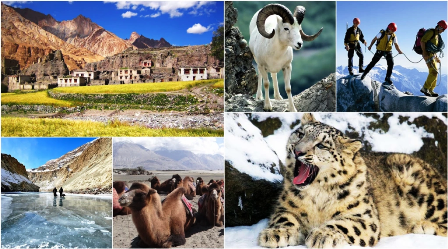Context:
In the heart of the majestic Himalayas lies Ladakh, a region of breathtaking beauty and cultural richness. However, beneath its serene exterior, Ladakh faces a multitude of challenges that threaten not only its own existence but also the well-being of humanity as a whole. At the forefront of this battle stands Sonam Wangchuk, a renowned climate activist, rallying the people of Ladakh and the world to confront the looming specter of climate change. As Ladakh grapples with the repercussions of rapid infrastructure development and the specter of environmental degradation, it serves as a microcosm of the global struggle against climate crisis.
The Fragile Ecosystem of Ladakh:
Nestled between the geopolitical giants of India, Pakistan, and China, Ladakh embodies a delicate balance of nature and human habitation. With its towering peaks and pristine landscapes, it serves as a sanctuary for indigenous tribes whose lives are intricately intertwined with the rhythms of the land. However, this fragile ecosystem is under siege from the relentless march of climate change. The Himalayan glaciers, often referred to as the Third Pole, are rapidly receding, threatening the primary source of water for millions downstream. The consequences of this meltdown extend far beyond the borders of Ladakh, impacting the lives and livelihoods of people across the Indian subcontinent.
Infrastructure Boom and Environmental Fallout:
The transition of Ladakh into a Union Territory ushered in an era of rapid infrastructure development aimed at bolstering connectivity and economic growth. However, this development frenzy has come at a grave cost to the environment and the local communities. Mega projects, including the construction of tunnels, roads, and solar energy installations, have irreversibly altered the landscape and disrupted fragile ecosystems. The zeal for progress has blinded policymakers to the warnings of past disasters, as evidenced by the tragic events in neighboring Uttarakhand. Despite the glaring risks, scant attention is paid to environmental impact assessments and the long-term sustainability of these projects, raising serious concerns about the prioritization of short-term gains over the preservation of natural resources.
Lessons from Tragedies:
The annals of Himalayan history are marred by tales of tragedy and loss, serving as stark reminders of the perils of environmental neglect. From the devastating cloudburst in Kedarnath to the collapse of the Silkyara tunnel, these events underscore the inherent vulnerability of mountainous regions to the vagaries of nature. Yet, in the aftermath of each disaster, the same patterns of disregard for environmental safeguards persist, perpetuating a cycle of destruction and despair. The plight of migrant workers and local residents bears witness to the human cost of unchecked development, underscoring the urgent need for a paradigm shift in policy and practice.
The Call for Action:
Amidst the cacophony of construction machinery and political rhetoric, a lone voice emerges, echoing the urgency of the climate crisis. Sonam Wangchuk's call for a 21-day climate fast reverberates across the barren landscapes of Ladakh, igniting a spark of hope in the hearts of thousands. Yet, the burden of responsibility cannot rest solely on the shoulders of individuals; it requires a collective effort from governments, corporations, and civil society. The National Mission for Sustaining the Himalayan Ecosystem (NMSHE) must reclaim its mandate to protect the Himalayan region from the ravages of climate change, prioritizing scientific assessment and sustainable practices. Similarly, regulatory bodies and development agencies must heed the lessons of the past and integrate environmental considerations into every stage of project planning and execution.
Conclusion:
In the crucible of Ladakh, the battle for survival unfolds against the backdrop of majestic peaks and icy rivers. It is a battle not only for the soul of this ancient land but for the very future of humanity. As we stand at the crossroads of history, the choices we make today will reverberate for generations to come. Let us heed the call to action, not out of fear or despair, but out of a deep reverence for the interconnected web of life that sustains us all. In protecting Ladakh, we safeguard not only a region but the collective heritage of humanity, ensuring a legacy of resilience and stewardship for posterity.
|
Probable Questions for UPSC Mains Exam 1. In the context of the environmental challenges faced by Ladakh, critically analyze the role of rapid infrastructure development in exacerbating the region's vulnerability to climate change. Discuss the implications of prioritizing short-term economic gains over the long-term sustainability of natural resources, with reference to specific examples from Ladakh and neighboring regions.(10 marks, 150 words) 2. Assess the effectiveness of existing government policies and institutional mechanisms, such as the National Mission for Sustaining the Himalayan Ecosystem (NMSHE), in addressing the climate crisis in Himalayan regions like Ladakh. Evaluate the role of regulatory bodies and development agencies in ensuring environmental protection and sustainable development, considering the lessons learned from past disasters and the ongoing infrastructure boom in the region.(15 marks, 250 words) |
Source: The Hindu









